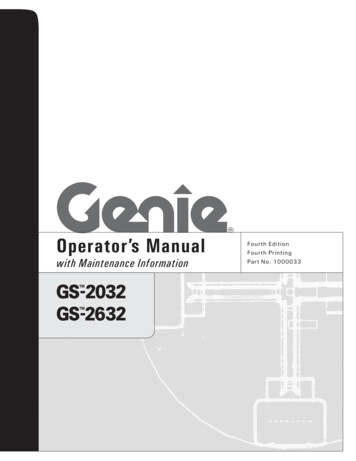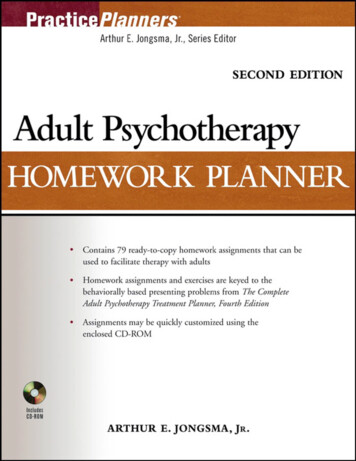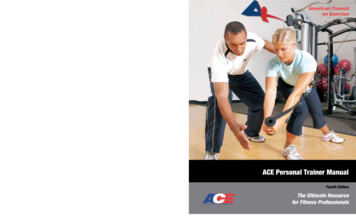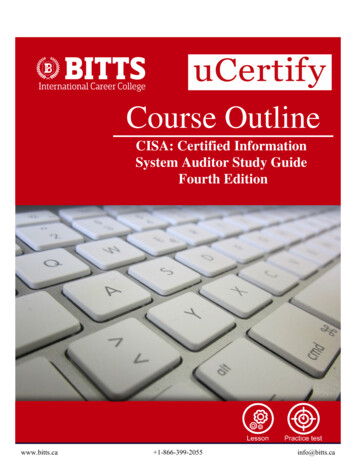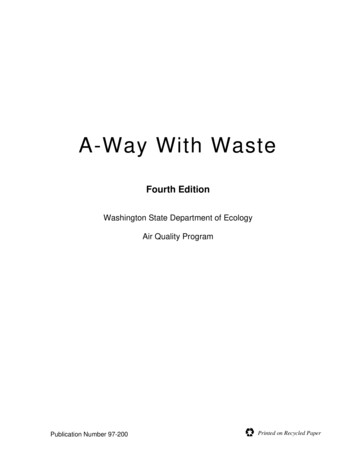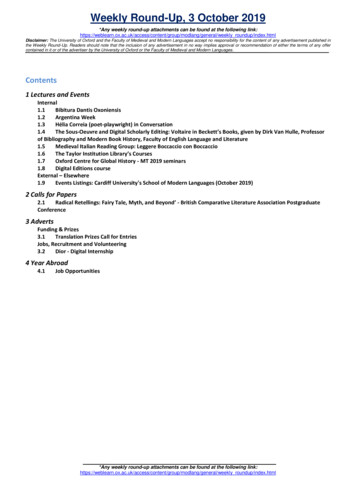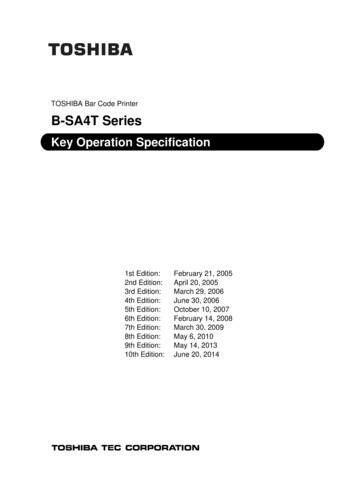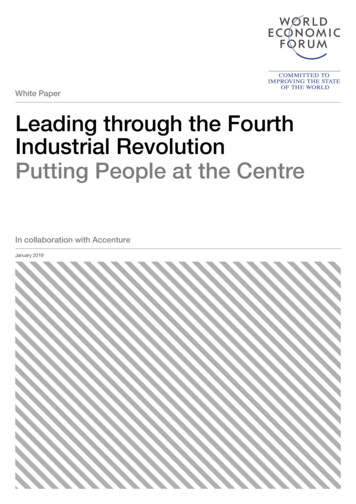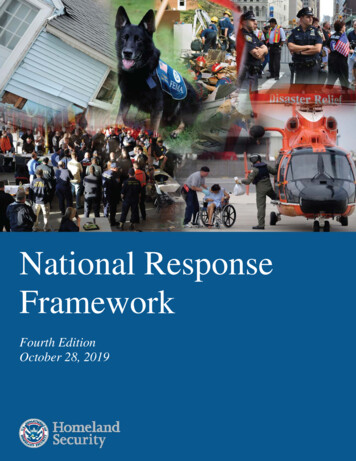
Transcription
National Response FrameworktNational ResponseFrameworkFourth EditionOctober 28, 2019i
National Response FrameworkExecutive Summar yThe National Response Framework (NRF) provides foundational emergency management doctrine forhow the Nation responds to all types of incidents. The NRF is built on scalable, flexible, and adaptableconcepts identified in the National Incident Management System (NIMS) to align key roles andresponsibilities across the Nation. The structures, roles, and responsibilities described in thisFramework can be partially or fully implemented in the context of a threat or hazard, in anticipation ofa significant event, or in response to an incident. Implementation of the structures and proceduresdescribed herein allows for a scaled response, delivery of specific resources and capabilities, and alevel of coordination appropriate to each incident.Responding to disasters and emergencies requires the cooperation of a variety of organizations; thelarger or more complex the incident, the greater the number and variety of organizations that mustrespond. Think of a residential fire: Firefighters are leading the charge; public works may be on sceneproviding traffic control; police are providing security; emergency medical services personnel aretriaging, transporting, and redistributing injured to local hospitals; and a local nonprofit or voluntaryorganization (e.g., American Red Cross and Salvation Army) may be on hand to assist displacedresidents. For large disasters, such as major hurricanes or earthquakes, the incident complexity isincreased as others—such as states or tribes and, ultimately, the Federal Government—becomeinvolved. Businesses, voluntary organizations, and other elements of the private sector are also keystakeholders, providing the essential services that must be restored following an incident. The NRFprovides the foundation for how these organizations coordinate, integrate, and unify their response.The unprecedented scale of recent disasters has spurred continued innovation in response operationsand highlighted the need for further progress to build resilient capabilities to respond to disasters ofincreasing frequency and magnitude. This fourth edition of the NRF embraces lessons-learned fromthose disasters and shares emerging best practices.Since publication of the third edition of the NRF in 2016, disaster response operations haveunderscored the paramount importance of sustaining essential community lifelines. The Frameworkdefines community lifelines as those services that enable the continuous operation of criticalgovernment and business functions and are essential to human health and safety or economic security.If disrupted, rapid stabilization of community lifelines is essential to restoring a sense of normalcy.Recent disasters have illuminated two underlying features of community lifelines that highlightopportunities to strengthen response planning and operations.First, community lifelines are interdependent and vulnerable to cascading failures. For example,communications and electric power systems rely on each other to function; severe damage to one willdisrupt the other. Most lifelines also rely on complex supply chains. Water and wastewater servicedepend on the resupply of a broad array of chemicals and—if power goes out—fuel for emergencygenerators. However, in a severe natural or human-caused incident, those supply chains themselvesmay be broken.Second, community lifeline stabilization relies on businesses and infrastructure owners and operatorswho have the expertise and primary responsibility for managing their systems in emergencies.Accordingly, new doctrine and coordination mechanisms are needed to enable the private sector toplay a larger, more comprehensive role in preparedness and response activities.The NRF is structured to help jurisdictions, citizens, nongovernmental organizations (NGO), andbusinesses develop whole community plans, integrate continuity plans, and build capabilities torespond to cascading failures among businesses, supply chains, and infrastructure sectors, as well ascollaborate with the private sector and NGOs to stabilize community lifelines and enable restorationii
National Response Frameworkof services in severe incidents. Critical infrastructure sector leadership (sector-specific agencies,government coordinating councils, and sector coordinating councils) create an established network tocollaborate with their respective private sector partners and support cross-sector 1 response operations.Often, Emergency Support Functions (ESF) work with sector leadership to bolster preparedness forcross-sector collaboration. This fourth edition of the NRF describes new initiatives that leverageexisting networks and better integrate business interests and infrastructure owners and operators intothe heart of emergency management.The NRF describes ways to improve coordination and response structures to build preparedness forcatastrophic incidents. Stabilizing community lifelines in catastrophic incidents is vital andextraordinarily difficult. Communities cannot meet these challenges solely by scaling up existing plansand capabilities. Rather, new mechanisms are needed to supplement and integrate those already inplace and facilitate cross-sector coordination, while respecting the roles of private sector partners andauthorities of agencies at all levels of government.A new ESF #14 – Cross-Sector Business and Infrastructure is introduced to focus on engaging privatesector interests and infrastructure owners and operators—particularly those in sectors not currentlyaligned to other ESFs—and conducting cross-sector analysis to help inform decision making. ESF #14relies on other ESFs aligned with a critical infrastructure sector to continue coordination with theircorresponding sector during response efforts. ESF #14 helps coordinate multi-sector responseoperations between (or across) the government and private sector for natural or human-causedcatastrophic incidents that jeopardize national public health and safety, the economy, and nationalsecurity.This edition of the Framework also builds on the response approach in previous editions to addressnational security emergencies. The National Security Strategy of the United States of America notesthat potential adversaries are developing advanced weapons and capabilities that could threaten U.S.critical infrastructure. 2 Adversaries may also strategically target attacks to exploit interdependenciesbetween infrastructure sectors and magnify cascading failures between them, posing incident responsechallenges above and beyond those created by earthquakes or other catastrophic natural hazards. Theinitiatives in this Framework address the resulting challenges for consequence management in waysthat supplement and support other government, private sector, and NGO plans and coordinatingstructures.1Cross-sector operations are those actions taken by public and private sector organizations from one or more of the16 critical infrastructure sectors to help entities or facilities associated with other sectors respond to an incident, beingfocused on preventing or mitigating cascading failures between sectors and restoring critical supply chains.2For more information on the National Security Strategy of the United States of America, 017/12/NSS-Final-12-18-2017-0905.pdf.iii
National Response FrameworkTable of ContentsIntroduction . 1Evolution of the Framework .1Framework Purpose and Organization .2Scope.3Intended Audience .5Guiding Principles .5Foundational Components . 8Prioritized Stabilization of Community Lifelines .8National Incident Management System .11Core Capabilities .12Operational Coordination . 15Private Sector Engagement .15Locally Executed Response .16State, Tribal, Territorial, and Insular Area Managed Response .18Federally Supported Response .19Roles and Responsibilities for Response . 25Communities .26Local Government .29State, Tribal, Territorial, and Insular Area Government .30Federal Government .34Federal Authorities. 42Federal Response and Assistance Under the Robert T. Stafford Disaster Relief andEmergency Assistance Act .43Federal Departments and Agencies Acting Under Their Own Authorities .44Federal-to-Federal Support .46International Support .46Federal Response and Assistance Available Without a Stafford Act Declaration.47iv
National Response FrameworkOperational Planning . 47Federal Planning .48Application for Planning .49Continuity Considerations .50Supporting Resources . 50Maintenance .50Conclusion. 51v
National Response FrameworkIntroductionThe National Preparedness System outlines an organized process for the whole community 3 to moveforward with its preparedness activities and achieve the National Preparedness Goal. The NationalResponse Framework (NRF) sets the strategy and doctrine for how the whole community builds,sustains, and delivers the response core capabilities identified in the National Preparedness Goal in anintegrated manner with the other mission areas. The fourth edition of the NRF emphasizes enhancingthe unity of effort between the government and the private sector through better coordination andcollaboration.E vo l u t i o n o f t h e F ra m ew o r kThe NRF builds on over 25 years of federal response guidance, beginning with the Federal ResponsePlan, published in 1992, and the National Response Plan, published in 2004. This fourth edition of theNRF reorganizes and streamlines the previous version of the NRF, expands principles andconcepts to better integrate government and private sector response efforts, and introduces thecommunity lifelines concept and terminology.This document supersedes the National Response Framework, Third Edition that wasissued in June 2016 and becomes effective 60 days after publication.Community lifelines are those services that enable the continuous operation of critical government andbusiness functions and are essential to human health and safety or economic security. In serious butpurely local incidents, interruptions of water service, electric power, and other community lifelinecomponents are typically brief and easy to mitigate. However, severe and widespread incidents canhalt lifeline services for many weeks or months. Such disruptions are especially extensive incatastrophic incidents and may result in mass casualties and other cascading consequences.Making community lifelines a core focus of incident response within the NRF offers unique benefitsfor incidents ranging from small-scale to catastrophic disasters. By building capabilities to stabilize4and accelerate the restoration of community lifeline services, it will be possible to save countless lives,limit damage to the economy, help maintain essential services for critical national security installations,reduce the initial impacts of disasters, and facilitate recovery operations. While the primary focus ofincident response remains on stabilizing community lifelines, other secondary considerations regardingthe natural and cultural environment and economic factors are equally as important.3Whole community includes individuals and communities, businesses, private and public sector owners and operatorsof critical infrastructure, faith-based organizations, nonprofit organizations, and all levels of government (local,regional/metropolitan, state, tribal, territorial, insular area, and federal). Whole community is defined in the NationalPreparedness Goal as “a focus on enabling the participation in national preparedness activities of a wider range ofplayers from the private sector, including nongovernmental organizations and the general public, in conjunction withthe participation of all levels of governmental in order to foster better coordination and working relationships.”4Stabilization occurs when immediate threats to life and property are anticipated, resourced, and managed and basiccommunity lifeline services are provided to survivors.1
National Response FrameworkCommunity lifelines provide a valuable decision-making construct to integrate cross-sector 5 responseoperations and reporting. Each lifeline depends on multiple infrastructure sectors, businesses, andsupply chains to function. Focusing on community lifelines allows emergency managers and theirpartners to account for these complex interdependencies and prioritize response operations to achievehigh-impact, multi-sector benefits. The Framework describes how the resources and capabilities of theFederal Government support such operations, while the new Emergency Support Function (ESF) #14– Cross-Sector Business and Infrastructure Annex describes how it facilitates coordination andcollaboration with business and infrastructure owners and operators to provide assistance and integratethe private sector's support during response, particularly for those sectors not currently aligned to otherESFs. Additional detail on the community lifelines can be found in the Prioritized Stabilization ofCommunity Lifelines section.Finally, the Framework’s focus on community lifelines necessitates deeper collaboration with theprivate sector and nongovernmental organizations (NGO). During the disasters of 2017 and 2018,individual businesses and infrastructure owners and operators (including public and private sectors)forged innovative, collaborative relationships with government agencies to help prioritize andaccelerate the stabilization of community lifeline services. The fourth edition of the NRF and ESF #14– Cross-Sector Business and Infrastructure Annex institutionalize their progress and build upon it inways that respect the authorities, responsibilities, and roles of all public, private, and NGO partnersessential to incident response.F r a m ew o r k P u rp o s e an d O rg an i z at i o nThe NRF is a guide to how the Nation responds to all types of disasters and emergencies. The NRF isbuilt on scalable, flexible, and adaptable concepts identified in the National Incident ManagementSystem (NIMS) to align key roles and responsibilities across the Nation. The NRF describes specificauthorities and best practices for managing incidents that range from the serious but purely local tothose that are catastrophic and national in scope.Within the NRF, the term “response” includes actions to save lives, protect property and theenvironment, stabilize the incident, and meet basic human needs following an incident. Response alsoincludes the execution of emergency plans and actions to enable recovery. The NRF describes doctrinefor managing all types of disasters or emergencies, regardless of scale, scope, and complexity. Thegoals and objectives herein explain common response disciplines and processes that have beendeveloped at all levels of government (local, state, tribal, territorial, insular area, 6 and federal) and havematured over time.To achieve the National Preparedness Goal, the objectives of the NRF are to do the following: Describe coordinating structures, as well as key roles and responsibilities for integratingcapabilities across the whole community, to support the efforts of governments, the private sector,and NGOs in responding to actual and potential incidents; Describe how unity of effort among public and private sectors, as well as NGOs, supports thestabilization of community lifelines and prioritized restoration of infrastructure during an incident5Cross-sector operations are those actions taken by public and private sector organizations from one or more of the16 critical infrastructure sectors to help entities or facilities associated with other sectors respond to an incident,focused on preventing or mitigating cascading failures between sectors and restoring critical supply chains. Theseoperations include measures taken by infrastructure owners and operators, businesses, and their government partnersto account for cross-sector interdependencies in incident response operations.6Per the Stafford Act, insular areas include Guam, the Commonwealth of the Northern Mariana Islands, American Samoa,and the U.S. Virgin Islands. Other statutes or departments and agencies may define the term “insular area” differently.2
National Response Frameworkand enables recovery, including the elements that support economic security, such as restorationof business operations and other commercial activities; Describe the steps needed to prepare for delivering the response core capabilities, includingcapabilities brought through businesses and infrastructure owners and operators in an incident; Foster integration and coordination of activities for response actions; and Provide guidance through doctrine and establish the foundation for continued improvement of theResponse Federal Interagency Operational Plan (FIOP), its incident annexes, as well asdepartment and agency plans that implement the FIOP.The NRF also advances progress under the National Security Strategy of the United States of America.The Framework helps achieve the strategy’s first pillar: to “protect the American people, the homeland,and the American way of life.” To accomplish this goal, the strategy calls for initiatives to strengthenthe Nation’s ability to withstand and recover rapidly from attacks and natural disasters. The NRF isstructured to help achieve these goals by establishing a new federal ESF coordinating structure to helpmitigate the impact of catastrophic incidents on community lifelines and account for the risk thatadversaries will seek to complicate and disrupt U.S. response operations.The NRF is composed of a base document, ESF annexes, and support annexes. The annexes providedetailed information to assist with the implementation of the NRF. ESF annexes describe the federal coordinating structures that group resources and capabilities intofunctional areas most frequently needed in a national response. Support annexes describe other mechanisms by which support is organized among private sector,NGO, and federal partners. The support annexes describe the essential supporting processes andconsiderations common to most incidents. Content found within the support annexes is supersededby changes and updates to legislation. The support annexes include the following: Financial managementInternational coordinationPublic affairsTribal relationsVolunteer and donations managementWorker safety and healthThe Critical Infrastructure and Key Resources Support Annex and Private Sector Coordination SupportAnnex, which supplemented previous versions of the NRF, have been superseded in this fourth editionof the NRF by ESF #14 – Cross-Sector Business and Infrastructure Annex, which has been added aspart of this updated framework. All references to these support annexes within the ESF or supportannexes should be read as referring to the ESF #14 – Cross-Sector Business and Infrastructure.S co p eThe NRF is a framework for all types of threats and hazards, ranging from accidents, technologicalhazards, natural disasters, and human-caused incidents. This Framework is utilized to implementNIMS and describes whole community coordinating structures and response activities; in particular,the Framework outlines government, private sector, and nongovernmental roles to reinforce3
National Response Frameworkcollaborative incident response. 7 The NRF also describes the structure and mechanisms for nationallevel policy and operational direction for incident management to ensure timely and effective federalsupport to local, state, tribal, territorial, and insular area governmental activities and survivors. TheNRF is applicable to all federal, local, state, tribal, territorial, and insular area departments and agenciesthat participate in operations requiring a coordinated federal response.NRF elements can be implemented at any time for any hazard, including the employment of ESFmechanisms. The structures, roles, and responsibilities described herein can be partially or fullyimplemented in the context of a threat or hazard, in anticipation of a significant event, or in responseto an incident. Implementation of NRF structures and procedures allows for a scaled response, deliveryof the specific resources and capabilities, and a level of coordination appropriate to each incident.The response mission area includes the capabilities necessary to stabilize an incident, save lives, protectproperty and the environment, meet basic human needs, restore community lifeline services and otherbasic community functionality, and establish a safe and secure environment to facilitate the integrationof recovery activities.In this fourth edition of the NRF, the thresholds for catastrophic incident response may vary dependingon one’s perspective. A localized flood can be catastrophic to an individual family who lost their homeand possessions, a severe tornado can be catastrophic to a town or city, and a hurricane can becatastrophic to a state or territory. At the national level, a catastrophic incident 8 is one of such extremeand remarkable severity or magnitude that the Nation’s collective capability to manage all responserequirements would be overwhelmed, thereby posing potential threats to national security, nationaleconomic security, and/or the public health and safety of the Nation. A national catastrophic incidentimplies that the necessary resources are not available within expected timeframes for incident response.During a national catastrophic incident, decision makers would be forced to consider the landscape ofrequirements and prioritize resources to manage shortfalls rather than to address all needs at once. Sucha situation would also require the extraordinary means of mobilizing and prioritizing national resourcesto alleviate human suffering; protect lives and property; reduce damage to natural, cultural, and historicresources; stabilize the Nation’s economy; and ensure national security.In this Framework, the term “incident” includes any occurrence, natural or manmade, that necessitatesa response to protect life or property and includes planned events, as well as emergencies or disastersof all kinds and sizes. The NRF’s structures and procedures address how federal departments andagencies coordinate support for local, state, tribal, territorial, and insular area governments and howgovernment at all levels works in unity with private sector and NGOs.Nothing in the NRF is intended to alter or impede the ability of a local, state, tribal, territorial, or insulararea government or Federal Government department or agency to carry out its authorities or meet itsresponsibilities under applicable laws, Executive orders, and directives.7The NRF must be consistent with all pertinent statutes and policies, particularly those involving privacy and civiland human rights, such as the Americans with Disabilities Act of 1990, the Rehabilitation Act of 1973, and the CivilRights Act of 1964.8The Post-Katrina Emergency Management Reform Act of 2006 defines the term “catastrophic incident” as “anynatural disaster, act of terrorism, or other man-made disaster that results in extraordinary levels of casualties or damageor disruption severely affecting the population (including mass evacuations), infrastructure, environment, economy,national morale, or government functions in an area.”4
National Response FrameworkI n t en d ed A u d i en ceThe NRF is intended to be used by communities; the private sector; NGOs; local, state, tribal,territorial, and insular area governments; and the Federal Government, as well as other entities involvedin response. The private sector includes for-profit and nonprofit organizations, formal and informalstructures, commerce, and industries that comprise the national economy and are not part of agovernment structure. NGOs are a distinct category of organizations within the private sector that caninclude voluntary, ethnic, faith-based, veteran-based, disability, 9 relief agency, and animal welfareorganizations, among others, and are referenced separately. This all-inclusive whole communityapproach focuses efforts and enables a full range of stakeholders to participate in national preparednessactivities and to be full partners in incident response, including emergency management practitioners,first responders, and community leaders.Infrastructure owners and operators (in private and public sectors), and other elements of the privatesector, are especially important partners for incident response and a key audience for the Framework.These partners are vital for strengthening the coordination between industry and government that isnecessary to stabilize community lifelines after major incidents or events. They are also crucial partnersfor creating the plans and doctrine to support essential functions for cross-sector response operations,especially where their ability to volunteer capabilities and expertise provides vital (and in some casesirreplaceable) contributions to protecting public health and safety. Moreover, because catastrophicincidents will create far more requests for emergency resources and types of government assistancethan can be immediately fulfilled, infrastructure owners and operators and other commercial interestscan help government agencies establish objective, nationwide criteria to help inform the allocation ofscarce resources to promote stabilization efforts, restore infrastructure, and to reduce morbidity andmortality.The fourth edition of the NRF describes how the whole community contributes to and benefits fromnational preparedness and integrated incident response. This includes children; 10 older adults;individuals with disabilities and others with access and functional needs; 11 those from religious, racial,and ethnically diverse backgrounds; people with limited English proficiency; and owners of animals,including household pets and service and assistance animals. Their individual contributions and needsmust be incorporated into response planning and delivery of the core capabilities. For furtherinformation, see the Core Capabilities section.G u i d i n g P ri n ci p l esThe following principles establish fundamental doctrine for the response mission area to supportlocally executed, state managed, and federally supported disaster operations: (1) engaged partnership;(2) tiered response; (3) scalable, flexible, and adaptable operational capabilities; (4) unity of effort9An individual who has a physical or mental impairment that substantially limits one or more major life activities (an“actual disability”) or a record of a physical or mental impairment that substantially limits a major life activity (“recordof”) or an actual or perceived impairment, whether or not the impairment limits or is perceived to limit a major lifeactivity that is not both transitory and minor (“regarded as”). Individuals with disabilities have civil rights protectionsthat may
The National Response Framework (NRF) provides foundational emergency management doctrine for how the Nation responds to all types of incidents. The NRF is built on scalable, flexible, and adaptable concepts identified in the National Incident Management System (NIMS) t
